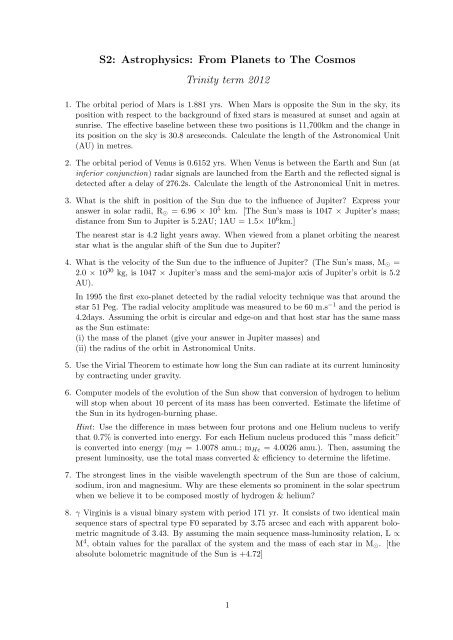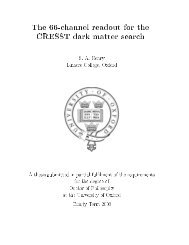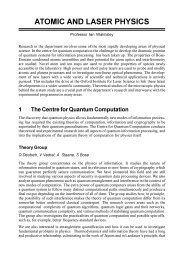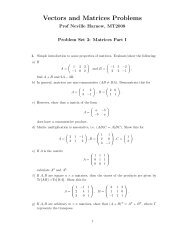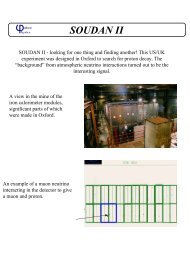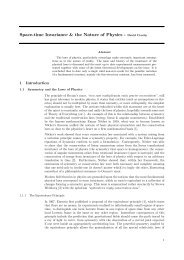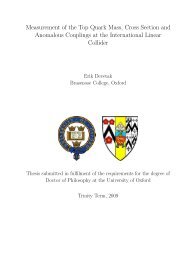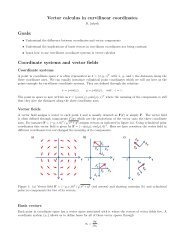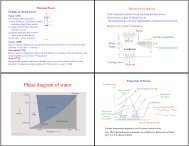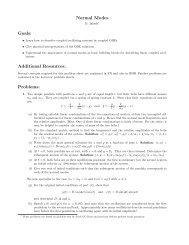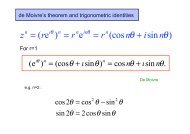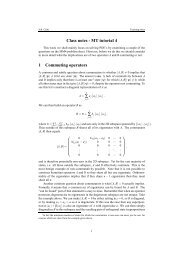S2: Astrophysics: From Planets to The Cosmos Trinity term 2012
S2: Astrophysics: From Planets to The Cosmos Trinity term 2012
S2: Astrophysics: From Planets to The Cosmos Trinity term 2012
Create successful ePaper yourself
Turn your PDF publications into a flip-book with our unique Google optimized e-Paper software.
<strong>S2</strong>: <strong>Astrophysics</strong>: <strong>From</strong> <strong>Planets</strong> <strong>to</strong> <strong>The</strong> <strong>Cosmos</strong><br />
<strong>Trinity</strong> <strong>term</strong> <strong>2012</strong><br />
1. <strong>The</strong> orbital period of Mars is 1.881 yrs. When Mars is opposite the Sun in the sky, its<br />
position with respect <strong>to</strong> the background of fixed stars is measured at sunset and again at<br />
sunrise. <strong>The</strong> effective baseline between these two positions is 11,700km and the change in<br />
its position on the sky is 30.8 arcseconds. Calculate the length of the Astronomical Unit<br />
(AU) in metres.<br />
2. <strong>The</strong> orbital period of Venus is 0.6152 yrs. When Venus is between the Earth and Sun (at<br />
inferior conjunction) radar signals are launched from the Earth and the reflected signal is<br />
detected after a delay of 276.2s. Calculate the length of the Astronomical Unit in metres.<br />
3. What is the shift in position of the Sun due <strong>to</strong> the influence of Jupiter? Express your<br />
answer in solar radii, R ⊙ = 6.96 × 10 5 km. [<strong>The</strong> Sun’s mass is 1047 × Jupiter’s mass;<br />
distance from Sun <strong>to</strong> Jupiter is 5.2AU; 1AU = 1.5× 10 6 km.]<br />
<strong>The</strong> nearest star is 4.2 light years away. When viewed from a planet orbiting the nearest<br />
star what is the angular shift of the Sun due <strong>to</strong> Jupiter?<br />
4. What is the velocity of the Sun due <strong>to</strong> the influence of Jupiter? (<strong>The</strong> Sun’s mass, M ⊙ =<br />
2.0 × 10 30 kg, is 1047 × Jupiter’s mass and the semi-major axis of Jupiter’s orbit is 5.2<br />
AU).<br />
In 1995 the first exo-planet detected by the radial velocity technique was that around the<br />
star 51 Peg. <strong>The</strong> radial velocity amplitude was measured <strong>to</strong> be 60 m.s −1 and the period is<br />
4.2days. Assuming the orbit is circular and edge-on and that host star has the same mass<br />
as the Sun estimate:<br />
(i) the mass of the planet (give your answer in Jupiter masses) and<br />
(ii) the radius of the orbit in Astronomical Units.<br />
5. Use the Virial <strong>The</strong>orem <strong>to</strong> estimate how long the Sun can radiate at its current luminosity<br />
by contracting under gravity.<br />
6. Computer models of the evolution of the Sun show that conversion of hydrogen <strong>to</strong> helium<br />
will s<strong>to</strong>p when about 10 percent of its mass has been converted. Estimate the lifetime of<br />
the Sun in its hydrogen-burning phase.<br />
Hint: Use the difference in mass between four pro<strong>to</strong>ns and one Helium nucleus <strong>to</strong> verify<br />
that 0.7% is converted in<strong>to</strong> energy. For each Helium nucleus produced this ”mass deficit”<br />
is converted in<strong>to</strong> energy (m H = 1.0078 amu.; m He = 4.0026 amu.). <strong>The</strong>n, assuming the<br />
present luminosity, use the <strong>to</strong>tal mass converted & efficiency <strong>to</strong> de<strong>term</strong>ine the lifetime.<br />
7. <strong>The</strong> strongest lines in the visible wavelength spectrum of the Sun are those of calcium,<br />
sodium, iron and magnesium. Why are these elements so prominent in the solar spectrum<br />
when we believe it <strong>to</strong> be composed mostly of hydrogen & helium?<br />
8. γ Virginis is a visual binary system with period 171 yr. It consists of two identical main<br />
sequence stars of spectral type F0 separated by 3.75 arcsec and each with apparent bolometric<br />
magnitude of 3.43. By assuming the main sequence mass-luminosity relation, L ∝<br />
M 4 , obtain values for the parallax of the system and the mass of each star in M ⊙ . [the<br />
absolute bolometric magnitude of the Sun is +4.72]<br />
1
Figure 1: <strong>The</strong> primary minimum in the light curve of the eclipsing binary system AR Lacertae,<br />
plotted as a function of phase (i.e. fraction of period). This system, whose period is 1.98 days<br />
is also a spectroscopic binary: the radial velocity curves of the two components are sinusoidal<br />
and have amplitudes of 116km s −1<br />
9. AR Lac is an eclipsing spectroscopic binary with period 1.98 days. <strong>The</strong> radial velocity<br />
curves of the two stars are sinusoidal with equal amplitudes of 116km.s −1 . <strong>The</strong> diagram<br />
(Fig. 1) shows the primary minimum in the light curve as a function of orbital phase.<br />
De<strong>term</strong>ine the masses and radii of the two components. Assume the orbit is edge on.<br />
10. By equating the gravitational acceleration at the surface of a neutron star <strong>to</strong> the centrifugal<br />
acceleration at the equa<strong>to</strong>r, calculate the size of a 3M ⊙ neutron star that can spin with<br />
a period of 1ms without disintegrating. What is the density implied? Compare this with<br />
nuclear densities.<br />
11. A mass m falls <strong>to</strong>wards a black hole and ends up in an orbit at three Schwarzschild radii<br />
from the balck hole (this the closest stable orbit <strong>to</strong> the black hole). Use the New<strong>to</strong>nian<br />
expression for the decrease in potential energy, and the assumption that half this decrease<br />
will be radiated away (from the Virial theorem), <strong>to</strong> estimate the fraction of the rest mass<br />
that will be radiated away in this process. How does that compare with the fraction of<br />
the rest mass released in the p-p chain that you calculated in Ques 6?<br />
2
12. <strong>The</strong> period-luminosity relation for Cepheid variable stars is:<br />
M V = −2.81LogP − 1.43 (1)<br />
where P is the period in days and M V is the absolute V-band magnitude. Cepheid variable<br />
stars are found in the M31 with a period of 31 days and an apparent V-band magnitude,<br />
m V = 18.6. Calculate the distance <strong>to</strong> M31 in kiloparsecs, assuming no absorption along<br />
the line-of-sight (either in M31 or the Milky Way).<br />
<strong>The</strong> radial velocity of M31 with respect <strong>to</strong> the Milky Way is -300km/s i.e. <strong>to</strong>wards the<br />
Milky Way. How do you interpret this?<br />
13. <strong>The</strong> star <strong>S2</strong> has an orbit around the Galactic Centre with a period of 15.9 years and a<br />
semi-major axis of 125 milli-arcsecs. Taking the distance <strong>to</strong> the Galactic Centre <strong>to</strong> be 8kpc<br />
calculate the mass of a compact object around which <strong>S2</strong> orbits.<br />
Sgr A* is the radio source at the centre of the Galaxy. When it it flares at X-ray wavelengths<br />
the flux increases by × 4 in 40 minutes. Estimate the size of the emitting region<br />
and compare it’s linear size <strong>to</strong> the semi-major axis of <strong>S2</strong>.<br />
14. <strong>The</strong> RAVE experiment measures the radial velocities of stars in the neighbourhood of the<br />
Sun and finds that the distribution of velocities implies an escape velocity from the Milky<br />
Way (at 8kpc radius) in the range 430-560 km.s −1 . What mass range interior <strong>to</strong> 8kpc do<br />
you estimate from this measurement?<br />
15. <strong>The</strong> Tully-Fisher relation calibrated from Hubble Space Telescope measurements of Cepheid<br />
variable stars in local galaxies is:<br />
M V = −7.8(log∆v − 2.5) − 20.5 (2)<br />
where M V is the absolute magnitude of the galaxy in the V-band and ∆v is the full<br />
width of the observed integrated line profile of neutral hydrogen emission. For the spiral<br />
galaxy NGC 3198 the width of the HI profile, ∆v = 300 km.s −1 , and the apparent V-band<br />
magnitude, m V = 10.4. Calculate the distance <strong>to</strong> NGC3198 in Mpc.<br />
<strong>The</strong> recession velocity of NGC3198 is 680 km.s −1 , what value of the Hubble constant is<br />
implied? If in fact H 0 = 72 km.s −1 .Mpc −1 what conclusion do you draw?<br />
16. A rich cluster of galaxies of radius 2Mpc contains 1000 elliptical galaxies with average<br />
luminosity 10 10 L ⊙ . An analysis of the colours and spectra of typical elliptical galaxies<br />
indicates that on average it takes 3M ⊙ <strong>to</strong> generate one L ⊙ . <strong>The</strong> rms velocity of galaxies<br />
in the cluster is 1300 km.s −1 . Make an estimate of the mass of the cluster. Compare the<br />
<strong>to</strong>tal mass in galaxies with mass of the cluster. What possibilities are suggested by this<br />
result?<br />
17. <strong>The</strong> present mass density of the Universe is 2.5 × 10 −27 kg.m −3 (about 2 pro<strong>to</strong>ns m −3 ) and<br />
the present day energy density in CMB pho<strong>to</strong>ns is 5 × 10 5 eV.m −3 . Compare the energy<br />
density in matter with the energy density in the CMB radiation <strong>to</strong>day, and calculate the<br />
redshift at which the two energy densities were equal.<br />
3


